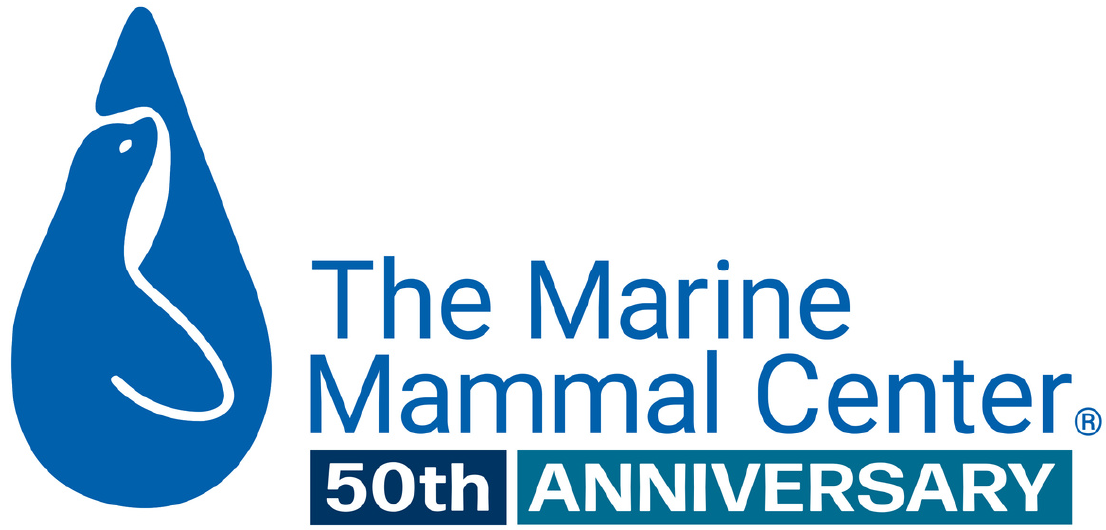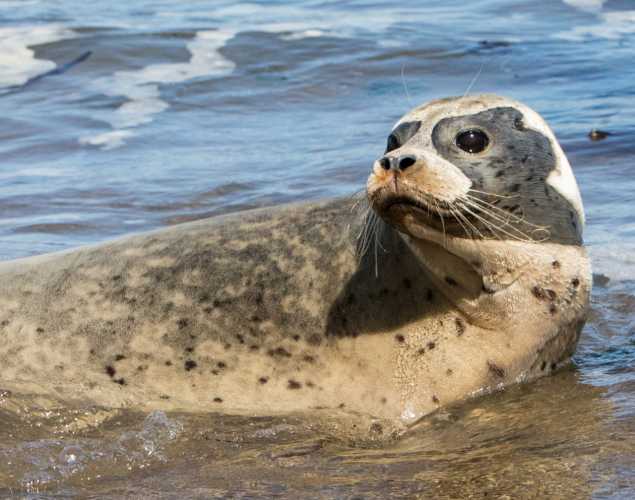
From Rescue to Release: Marine Mammal Patients Seen Thriving in the Wild
- Malnutrition
- Species conservation
- Entanglement
- Ocean trash
Meet Lucinda, Ariel, Sallyfur and Meleana—four marine mammal patients that have been spotted thriving in the wild since their release thanks to ocean heroes like you.
As the world’s largest marine mammal hospital, The Marine Mammal Center has rescued more than 27,000 marine mammals, like seals, sea lions and sea otters, with the goal of rehabilitating and returning them to their ocean home. The expert medical care these animals receive is possible thanks to kind people like you.
At our hospital, all of our patients receive bright orange flipper tags with identification numbers. This allows us to track individuals if they are spotted again in the wild throughout their lives. Whether it’s a couple days or many years after their release, seeing a tagged animal thriving in their natural habitat is an exciting moment. When we make that match in our patient database, our experts can gain important insights that help improve the care we provide and our long-term impact on advancing ocean health.
Read on to meet some of our seal and sea lion patients that have been rehabilitated and released thanks your support. With a second chance at life, they’re swimming across the farthest stretches of the ocean, successfully foraging for food, and even having pups of their own. How do we know? These marine mammals have been resighted—healthy, strong and thriving.
Pacific Harbor Seal Lucinda
Pacific harbor seal Lucinda was rescued as a pup in 2020 with a severe entanglement. Sadly, three hooks were lodged in her cheek, tongue and flipper (all attached by a strand of tangled fishing line) and a fourth hook was embedded inside her stomach.
At our hospital, our veterinarians examined this pup using advanced equipment that allowed them to see inside her tiny body and find the fourth hook. It’s thanks to your generosity that these medical devices are part of our experts’ tool kit, allowing them to give each patient the best possible care.
Lucinda recovered well from her disentanglement surgery, and after about a month of care, she was released back to her ocean home.
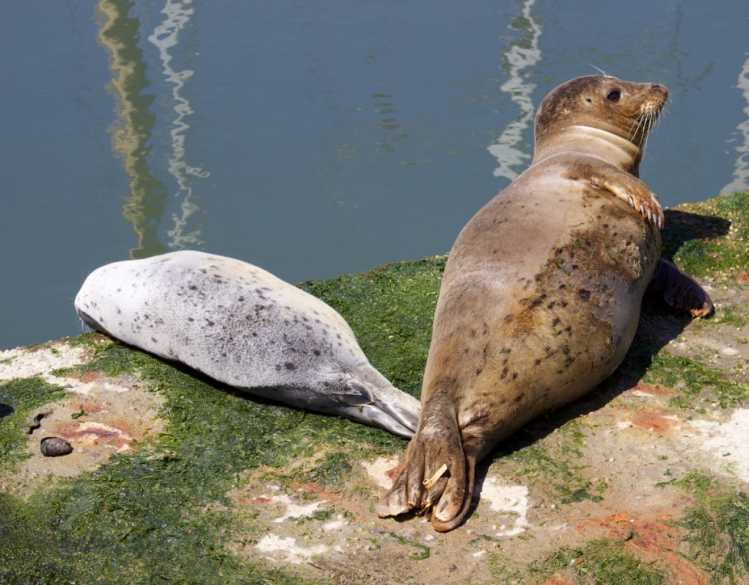

Despite being once entangled and with her life at stake, Lucinda has been spotted in Sausalito, California every year since her release looking plump and healthy. Her most heartwarming resightings? In May 2024 Lucinda was seen resting safely in a harbor alongside her very own pup. And in March 2025 she was seen again with another adult harbor seal, and both seals were suspected to be pregnant.
You can help the next marine mammal in need when you adopt Lucinda today!
California Sea Lion Ariel
California sea lion Ariel was rescued in November 2018 when the Center’s experts were training marine mammal responders in Baja, Mexico. Working closely with local veterinarians and international alumni of our Teaching Hospital, we carefully administered anesthesia to the young sea lion and cut the life-threatening entanglement around her neck. Finally free of ocean trash, Ariel returned to the wild with a second chance at life.
More than three years later, Ariel was spotted resting on the beach. Not only was this sea lion healed and healthy after her disentanglement, but she also had a newborn pup with a belly full of milk by her side.


Just as rescuing Ariel from her entanglement also led to a thriving future for this sea lion and her young pup, our global collaboration creates a ripple effect for marine mammal rescue and ocean health. After training with the Center, veterinary professionals from around the world are bringing their new skills back home and building life-saving response programs to help more entangled animals like Ariel on a global scale—all thanks to support from people like you.
Guadalupe Fur Seal Sallyfur
Guadalupe fur seal Sallyfur was admitted to our hospital in May 2017 during an Unusual Mortality Event for this threatened species. Not only was this 10-month-old pup starving and exhausted when she was rescued, but she also had domoic acid, a potentially deadly neurotoxin, in her body. Thankfully, she received the food and medicine needed to recover and return to her ocean home.
Guadalupe fur seals spend most of their time in the open ocean offshore of North America, but when on land, they are primarily found on Guadalupe Island, the only known breeding colony that’s about 150 miles off the coast of the Baja California peninsula. Because so little is known about this elusive species, the Center’s researchers use satellite tags to track their movements over several months and work closely with scientists in Mexico to conduct population counts, health assessments and other studies.


While censusing the species on Guadalupe Island in the summer of 2024, our collaborators from Mexico spotted an adult female fur seal with a bright orange flipper tag, a sign that she had been a patient released from rehabilitation in the United States. Identified as now-8-year-old Sallyfur, she is the first Guadalupe fur seal we have rehabilitated as a pup at the Center and resighted in the wild as an adult.
Each individual Guadalupe fur seal is essential to saving this threatened species, and Sallyfur thriving in the wild more than seven years after her release is a conservation success that people like you make possible.
Hawaiian Monk Seal Meleana
Hawaiian monk seal Meleana was a very malnourished and skinny pup when she was rescued in September 2014. In fact, she weighed half of what she should have weighed at the time—an unfortunate but common fate for monk seal pups. Without intervention, Meleana likely would have died.
During her six-month stay at Ke Kai Ola, our Hawai‘i hospital dedicated to saving this endangered species, she received expert care and gained a substantial and healthy amount of weight, going from 51 pounds to 246 pounds. Meleana was released to the Northwestern Hawaiian Islands with a second chance at life.


Meleana, whose name means “continuous song,” has been resighted multiple times since her release—including seven years later with a pup of her own! In a sign of hope for the next generation of endangered Hawaiian monk seals, in 2022 researchers at the National Oceanic and Atmospheric Administration (NOAA) confirmed that Meleana and a second monk seal that had been rehabilitated at Ke Kai Ola, Amaʻama, became new moms.
The birth of these two Hawaiian monk seal pups from former patients is a significant milestone for this endangered species and is a powerful example of our conservation efforts.
Seeing our patients and their young pups thriving in the wild is a testament to the Center’s longstanding impact and provides important insights into the care we provide each patient. It’s all thanks to kind people like you that thousands of sick, injured and orphaned marine mammals can receive expert care for a second chance at life. And as much as our work is about helping each animal like Lucinda, Ariel, Sallyfur and Meleana, it is also about populations as a whole and the health of our ocean for generations to come.
Yes, I want to save a life!
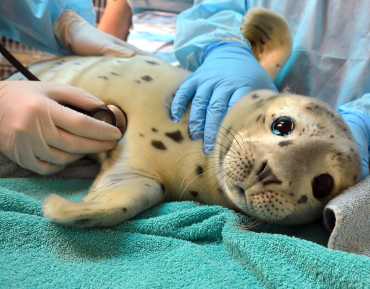
Yes, I want to save a life!
You’ll be giving sick and injured animals the best possible care at the Center’s state-of-the-art hospital. With your gift today, you are giving a patient a second chance at life in the wild.
See Our Latest News
{"image":"\/Animals\/Patients\/Harbor seals\/2020\/cropped-images\/hs-barnwood-by-bill-hunnewell-c-the-marine-mammal-center-315-0-3299-2577-1607370547.jpg","alt":"harbor seal Barnwood","title":"Last-Minute Gift Guide \u2013 Top Gifts that Give Back to Marine Animals","link_url":"https:\/\/www.marinemammalcenter.org\/news\/last-minute-gift-guide","label":"News Update","date":"2025-12-18 01:00:00"}
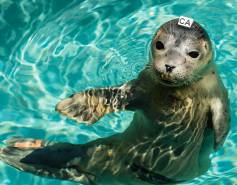
Last-Minute Gift Guide – Top Gifts that Give Back to Marine Animals
December 18, 2025
Read More{"image":"\/Animals\/Patients\/Hawaiian monk seals\/2025\/cropped-images\/b-ru72admission-to-ke-kai-ola112125photo-c-the-marine-mammal-center-noaa-permit-24359-0-364-1270-992-1766095407.jpg","alt":"A newborn Hawaiian monk seal pup with a black coat in rehabilitative care.","title":"Newborn Hawaiian Monk Seal Pup Now Receiving Care","link_url":"https:\/\/www.marinemammalcenter.org\/news\/newborn-hawaiian-monk-seal-pup-now-receiving-care","label":"Patient Update","date":"2025-12-18 01:00:00"}

{"image":"\/Animals\/Patients\/Hawaiian monk seals\/2025\/cropped-images\/d-ru28release-exam-at-ke-kai-ola111025photo-by-giancarlo-rulli-c-the-marine-mammal-center-noaa-permit-24359-0-0-1270-992-1764620886.jpg","alt":"","title":"Bird Flu Vaccine Trial Offers Hope for Protecting Hawaiian Monk Seals","link_url":"https:\/\/www.marinemammalcenter.org\/news\/bird-flu-vaccine-trial-may-offer-hope-for-protecting-hawaiian-monk-seals","label":"News Update","date":"2025-12-01 08:13:00"}

Bird Flu Vaccine Trial Offers Hope for Protecting Hawaiian Monk Seals
December 1, 2025
Read More{"image":"\/Animals\/Patients\/Hawaiian monk seals\/2021\/hms-pp08-by-sheila-latta-c-the-marine-mammal-center-noaa-permit-18786.jpg","alt":"Hawaiian monk seal","title":"The New York Times: Inside the Bird-Flu Vaccine Trial for Monk Seals","link_url":"https:\/\/www.marinemammalcenter.org\/news\/the-new-york-times-inside-the-bird-flu-vaccine-trial-for-monk-seals","label":"In the News","date":"2025-12-01 01:00:00"}

The New York Times: Inside the Bird-Flu Vaccine Trial for Monk Seals
December 1, 2025
Read More